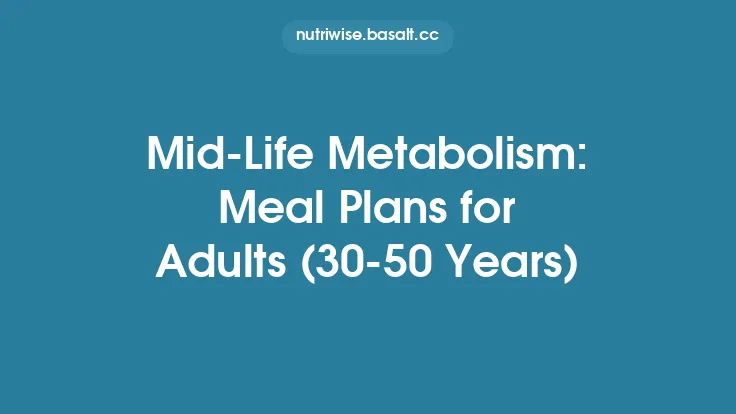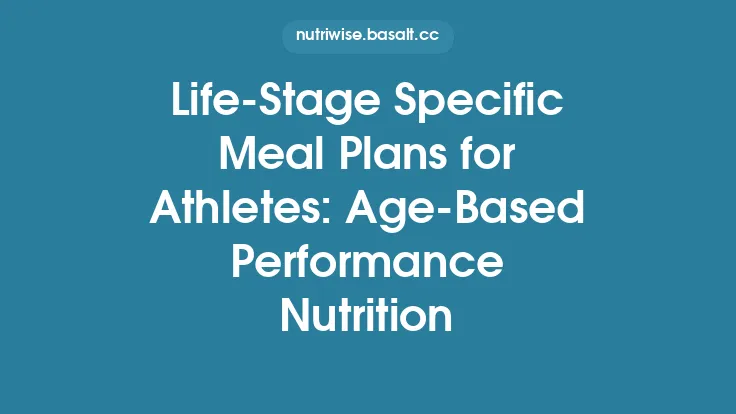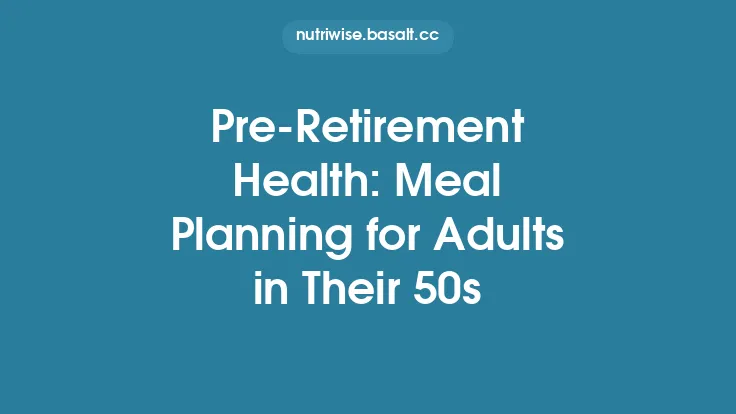Menopause brings a cascade of hormonal shifts that can affect everything from bone density to sleep quality, mood, and weight management. While no single food can “cure” menopause, a thoughtfully designed meal plan can smooth the transition by supporting estrogen balance, stabilizing blood sugar, reducing inflammation, and supplying the nutrients most at risk during this stage of life. Below is a comprehensive guide to building menopause‑friendly meal plans, complete with the science behind key nutrients, practical food‑selection strategies, sample weekly menus, and tips for sustainable implementation.
Understanding the Hormonal Landscape
During perimenopause and menopause, ovarian production of estrogen and progesterone declines dramatically. This hormonal dip triggers several physiological changes:
| Change | Typical Impact | Nutritional Countermeasure |
|---|---|---|
| Decreased estrogen | Reduced bone mineral density, increased cardiovascular risk, hot flashes | Calcium, vitamin D, magnesium, phytoestrogens (isoflavones, lignans) |
| Fluctuating blood glucose | Weight gain, insulin resistance | Fiber, low‑glycemic carbs, chromium, omega‑3 fatty acids |
| Increased cortisol (stress hormone) | Sleep disturbances, mood swings | B‑vitamins, vitamin C, magnesium, adaptogenic herbs |
| Altered lipid profile | Higher LDL, lower HDL | Soluble fiber, plant sterols, omega‑3s |
| Reduced muscle mass (sarcopenia) | Lower basal metabolic rate, frailty | High‑quality protein, leucine‑rich foods, vitamin D |
By targeting these pathways with specific nutrients, a menopause‑focused meal plan can mitigate many of the common symptoms.
Core Nutrient Pillars
1. Calcium & Vitamin D
- Why: Essential for bone remodeling; estrogen deficiency accelerates bone loss.
- Sources: Low‑fat dairy (milk, yogurt, cheese), fortified plant milks, sardines with bones, tofu set with calcium sulfate, leafy greens (collard, kale). Vitamin D comes from fatty fish (salmon, mackerel), egg yolk, fortified foods, and safe sun exposure (10–15 min midday, 2–3 times/week).
2. Magnesium
- Why: Supports bone health, regulates blood pressure, and calms the nervous system (helps with night sweats).
- Sources: Pumpkin seeds, almonds, black beans, quinoa, avocado, dark chocolate (≥70 % cacao).
3. Phytoestrogens (Isoflavones & Lignans)
- Why: Plant compounds that weakly bind estrogen receptors, offering mild estrogenic activity that can ease hot flashes.
- Sources: Soy products (tofu, tempeh, edamame), flaxseed (ground), sesame seeds, lentils, chickpeas.
4. Omega‑3 Fatty Acids (EPA/DHA)
- Why: Anti‑inflammatory, improve lipid profile, support brain health and mood.
- Sources: Fatty fish (salmon, sardines, herring), algae oil (vegan), walnuts, chia seeds, flaxseed oil.
5. Soluble Fiber
- Why: Lowers LDL cholesterol, stabilizes glucose, promotes satiety.
- Sources: Oats, barley, apples, pears, carrots, legumes, psyllium husk.
6. High‑Quality Protein
- Why: Preserves lean muscle mass, boosts thermogenesis, aids satiety.
- Sources: Lean poultry, fish, eggs, Greek yogurt, cottage cheese, plant proteins (lentils, peas, soy).
7. B‑Vitamins & Vitamin C
- Why: Support energy metabolism, reduce cortisol spikes, aid collagen synthesis for skin elasticity.
- Sources: Whole grains, leafy greens, citrus fruits, bell peppers, nuts, seeds.
Building a Balanced Plate
A menopause‑friendly plate follows the classic “half‑plate vegetables, quarter protein, quarter whole grains” model, with strategic additions:
| Plate Section | Recommended Foods | Portion Tips |
|---|---|---|
| Vegetables (≈½ plate) | Dark leafy greens, cruciferous veg (broccoli, Brussels sprouts), colorful veggies (red peppers, carrots) | Aim for at least 2–3 cups raw or cooked daily |
| Protein (≈¼ plate) | Fatty fish, poultry, eggs, tofu, tempeh, legumes | 4–6 oz cooked weight per meal; include a plant‑based source 2–3 times/week |
| Whole Grains (≈¼ plate) | Quinoa, brown rice, farro, whole‑wheat pasta, oats | ½–1 cup cooked per meal |
| Healthy Fats | Olive oil drizzle, avocado slices, nuts/seeds | 1–2 tbsp oil or ¼ cup nuts/seeds daily |
| Calcium‑Rich Add‑On | Yogurt, fortified plant milk, cheese, tofu | 1 cup dairy or fortified alternative per day |
| Phytoestrogen Boost | Ground flaxseed (1 tbsp), soy milk (½ cup) | Sprinkle into smoothies, oatmeal, or sauces |
Sample Weekly Meal Plan
> Note: Caloric needs vary; the plan below targets ~1,800 kcal/day for a moderately active woman aged 50–55. Adjust portions up or down based on individual energy expenditure.
Day 1
- Breakfast: Greek yogurt parfait with ½ cup mixed berries, 2 tbsp ground flaxseed, and ¼ cup granola (whole‑grain).
- Mid‑Morning Snack: Handful of almonds (¼ cup).
- Lunch: Quinoa salad with roasted chickpeas, kale, cherry tomatoes, cucumber, and lemon‑tahini dressing; side of orange slices.
- Afternoon Snack: Apple with 1 tbsp almond butter.
- Dinner: Baked salmon (5 oz) with herb‑olive oil, steamed broccoli, and sweet‑potato mash (½ cup).
- Evening: Warm milk (dairy or fortified soy) with a pinch of cinnamon.
Day 2
- Breakfast: Oatmeal cooked in fortified soy milk, topped with sliced banana, 1 tbsp chia seeds, and a drizzle of honey.
- Snack: Hard‑boiled egg + carrot sticks.
- Lunch: Lentil soup (1 cup) with a side mixed greens salad (2 cups) dressed with olive oil & balsamic.
- Snack: Greek yogurt (½ cup) with a sprinkle of pumpkin seeds.
- Dinner: Stir‑fried tofu (4 oz) with bell peppers, snap peas, and brown rice (½ cup).
- Evening: Herbal tea (peppermint) and a square of dark chocolate (≥70 % cacao).
Day 3
- Breakfast: Smoothie: spinach, frozen berries, ½ cup fortified almond milk, 1 tbsp hemp protein, 1 tbsp ground flaxseed.
- Snack: Cottage cheese (½ cup) with pineapple chunks.
- Lunch: Turkey and avocado wrap in a whole‑wheat tortilla, side of mixed fruit salad.
- Snack: Celery sticks with 2 tbsp hummus.
- Dinner: Grilled sardines (4 oz) with quinoa tabbouleh (½ cup) and roasted Brussels sprouts.
- Evening: Warm chamomile tea.
*(Repeat the pattern, rotating protein sources—e.g., tempeh, shrimp, lean beef, eggs—and varying vegetables to ensure a broad micronutrient spectrum.)*
Grocery List Essentials
- Proteins: Salmon, sardines, skinless chicken breast, turkey slices, tofu, tempeh, eggs, Greek yogurt, cottage cheese, lentils, chickpeas, black beans.
- Whole Grains: Quinoa, brown rice, farro, whole‑wheat pasta, rolled oats, whole‑grain tortillas.
- Dairy/Alternatives: Low‑fat milk, fortified soy/almond oat milk, cheese (moderate).
- Fruits & Veggies: Berries, apples, oranges, bananas, leafy greens (kale, spinach, collard), cruciferous veg, bell peppers, carrots, cucumbers, sweet potatoes, avocados.
- Healthy Fats & Seeds: Olive oil, avocado oil, almonds, walnuts, pumpkin seeds, chia seeds, ground flaxseed, sesame seeds.
- Flavor & Extras: Fresh herbs, garlic, ginger, lemon, lime, low‑sodium soy sauce, spices (cinnamon, turmeric, black pepper).
- Beverages: Herbal teas, sparkling water, coffee (moderate).
Practical Tips for Long‑Term Success
- Batch‑Cook Protein: Grill a tray of salmon or bake a batch of tofu on Sunday; store in portioned containers for quick weekday meals.
- Prep Veggies Ahead: Wash, chop, and store vegetables in airtight containers; keep a mix of raw (for snacks) and pre‑roasted (for salads).
- Mindful Portioning: Use the “hand” method—palm for protein, cupped hand for carbs, fist for veggies—to keep portions consistent without constant weighing.
- Hydration & Hot Flashes: Aim for 2–2.5 L water daily; sip cool herbal teas (sage, peppermint) which may reduce flush intensity.
- Timing of Calcium: Spread calcium intake throughout the day; avoid taking high‑dose calcium supplements with iron‑rich meals as they can interfere with absorption.
- Limit Triggers: Reduce caffeine, alcohol, and spicy foods if they exacerbate night sweats; opt for low‑glycemic snacks to avoid blood‑sugar spikes.
- Track Symptoms: Keep a simple journal linking meals to hot flashes, mood, sleep quality; over time, patterns emerge that guide further tweaks.
Frequently Asked Questions
Q: Can soy worsen estrogen‑related cancers?
A: Current evidence suggests moderate soy consumption (1–2 servings/day) is safe for most post‑menopausal women and may even lower breast cancer risk. Women with a personal history of hormone‑sensitive cancers should consult their physician.
Q: How much calcium do I need?
A: The Recommended Dietary Allowance (RDA) for women 51 + years is 1,200 mg/day. Aim for a combination of food sources and, if needed, a supplement that provides ≤500 mg per dose to enhance absorption.
Q: Are supplements necessary?
A: Whole foods are the preferred source. However, vitamin D (800–1,000 IU/day) and calcium supplements can be useful when dietary intake falls short, especially in winter months or limited sun exposure.
Q: What about weight gain?
A: Hormonal changes can shift fat storage toward the abdomen. Prioritizing protein, fiber, and healthy fats while maintaining a modest calorie deficit (≈250 kcal/day) supports gradual, sustainable weight loss.
Q: Can I follow a vegetarian or vegan plan?
A: Absolutely. Emphasize soy, legumes, nuts, seeds, fortified plant milks, and consider a B12 supplement. Ensure adequate omega‑3s via algae oil or ground flaxseed + chia.
Integrating Lifestyle for Holistic Relief
Nutrition is a cornerstone, but pairing it with other menopause‑supportive habits amplifies benefits:
- Regular Weight‑Bearing Exercise: 2–3 sessions/week of walking, dancing, or resistance training strengthens bone and preserves muscle mass.
- Stress Management: Yoga, meditation, or deep‑breathing reduces cortisol, which can otherwise aggravate hot flashes and sleep disturbances.
- Sleep Hygiene: Keep the bedroom cool (≈18 °C/65 °F), limit screen time before bed, and maintain a consistent sleep schedule.
- Mindful Eating: Slow, attentive meals improve satiety signals and help regulate blood glucose.
Closing Thoughts
Menopause is a natural phase, not a medical crisis, and the foods we choose can be powerful allies in navigating its challenges. By centering meals around calcium‑rich dairy or fortified alternatives, magnesium‑laden nuts and seeds, phytoestrogen‑rich legumes, omega‑3 fatty acids, and abundant colorful vegetables, you create a nutritional environment that supports bone health, cardiovascular wellness, mood stability, and metabolic balance.
Start with small, sustainable changes—swap refined grains for whole grains, add a tablespoon of ground flaxseed to your morning bowl, or replace a sugary snack with a handful of almonds. Over weeks and months, these adjustments compound, turning everyday meals into a personalized, menopause‑friendly nutrition plan that not only eases symptoms but also lays the foundation for vibrant health well beyond the transition.





